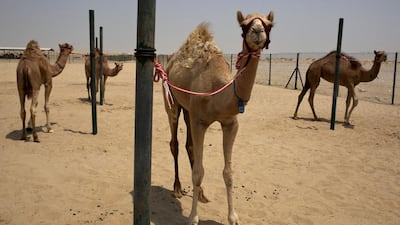“This is not a camel, this is a car!” At these words, Sheikh Zayed jumped from his seat and asked for the name of the camel.
It was the early 1970s, long before racing was established as a formal sport and long before camels were established as swift. (A point, perhaps, still debatable.)
It was Shaheen who convinced the Bedouin and sheikhs that camels, like horses, could race at speed and achieve elegance on the racetrack.
When Sheikh Zayed saw this camel, it was unknown and still called by its father’s name, Al Musk, a famous camel owned by the Ruler of Umm Al Qaiwain.
Sheikh Zayed then asked the name of the camel’s owner.
“My name is Shaheen,” said the owner, Shaheen Al Awani, stepping forward.
Sheikh Zayed decreed that the marvelous camel and all its descendants would hitherto be known by its owner’s name, Shaheen. This is the story told by Bedouin of how Shaheen got its name.
The 2014 World Cup has made Shaheen a household name in the Emirates. Not one but two descendants of the original Shaheen have predicted World Cup football match outcomes, albeit with mixed success.
But no camel compares to Shaheen the First.
By the end of his first race season in 1973-4, the prodigy camel was sold to Sheikh Hamdan bin Rashid, the brother of Dubai Ruler Sheikh Mohammed bin Rashid, for a record Dh3,700.
You cannot buy a camel for such a small sum today, but in 1974 this was more than 10 times the going rate for a camel, which usually sold for Dh200-300 or Dh2,000 at the absolute most.
At that point, Shaheen was already renowned among the Bedouin of Ras Al Khaimah, where he raced at weddings in the days before racetracks existed.
“It would be very rare that he would ever lose a race, and most of all it was very famous in Ras Al Khaimah itself,” Al Awani’s son, Mohammed, told me a few years ago. “People used to be really scared of racing against Shaheen. People would give my father the prize and say, ‘Don’t race Shaheen because he will certainly be the winner’.”
With Shaheen, there was no competition. He raced against camels twice his age and size. He raced against camels of Sudanese descent, which are known to be the most light footed of camels.
He raced at weddings up to the bride’s house, where women covered his necks in saffron paste, a tradition continued to this day. Shaheen’s victories came so quickly, one after the other, that the smell of saffron sank into his fur and he always smelt of its perfume.
Shaheen produced many daughters and sons that became famous in their own right, like Shaheen Al Khalili and Shaheen Al Ghazaila.
The original Shaheen came to be known as Shaiba Shaheen, Old Man Shaheen.
It is said in Ras Al Khaimah that Shaiba Shaheen underwent taxidermy after death, and his photograph still hangs in Sheikh Hamdan’s home.
Today is an era of celebrity and it sometimes seems that any old camel can make a claim to fame. But in Shaheen’s time, before races were televised lived or ballads were shared on WhatsApp or camels were hashtagged, camel celebrity was truly rare, spread only by those who could witness the camel’s power and the poets who sung its praise.

